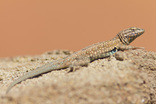Request for Access to Private Lands
In an effort to demonstrate the importance of private range lands in reptile conservation, we are seeking permission to access private lands in the Great Plains. We are particularly interested in areas with sparse public lands, but will consider any lands that meet the following requirements:
|
Private rangelands in the central and southern Great Plains may provide ideal native habitat conditions for many reptile species. (D. Martin photo).
|
If this sounds like a project you can support by providing land access, please complete the form at the bottom of the page. We will be in touch with you as soon as possible to discuss any details and answer any of your questions!
FAQs for Landowners1) Are you looking for any federally or state-listed Threatened and Endangered (T&E) Species?
Our interest is in estimating the current distributions of all terrestrial reptile species native to the Great Plains region. We are interested in 'common' species just as much as we are in those with more limited distributions. Refer to list below for current T&E species in our area of interest. See also FAQ #4 below. 2) Will citizen volunteers be able to access my property? I only want CSU crews on my land. Volunteer will only be given access if you request it. We typically only allow professional crews from CSU to access private properties. Our crews are aware of private landowner concerns, such as calling ahead of a site visit when requested, leaving open gates open / closing closed gates, and not driving across grass. 3) Can you control rattlesnake populations on my property? No. The goal of this project is to identify environmental correlates to changes in reptile distributions. If we influence changes in any populations of reptiles, we are no longer able to document naturally-occurring trends in those populations across the landscape. If this is a condition of providing access, we will be unable to survey your property. 4) Who will know about my involvement with the project? We are required as part of our state permits to report our observations to state wildlife agencies. We can request that state agencies keep locations of reptiles observed on your property from being available through the Freedom of Information Act (or state analog), since it is part of an active research project. CSU does not otherwise provide information of your involvement to anyone without your permission. 5) I would like to meet up with the CSU crew before they access my property the first time. Is that okay? Absolutely. This is, after all, your property. We typically like to meet with landowners the first time to a property to get a better idea of access issues (e.g., location of double-track roads, gates, etc...) we need to be aware of. You are also welcome to come out with crews while they are on your property! |
Many ranchers we have spoken to have noticed that they don't see as many horned lizards, for example, as they used to. Why? Is it because they spend less time on foot now than when they were younger, and populations are the same - just not as frequently observed? Is it due to real declines due to prolonged drought, invasive fire ants, invasive weedy plants such as cheatgrass, widespread use of DDT in the past century, or something else?
The Colorado Checkered Whiptail is found only in southeastern parts of the state, and has been petitioned to be federally-listed under the ESA. Through our project we aim to provide an improved understanding of the current distribution of this species. Similar to many other reptiles, there is currently little information about their distributions and population trends - the information this project collects should help the USFWS make a better-informed decision about the listing of this species.
|
*Species indexed below are those with distributions within the Great Plains ecoregion in a given state. Several species with peripheral distributions to our area of interest are not indexed above.
Reptiles with Federal T&E Status*NO SPECIES are currently Federally-listed.
Species currently under consideration for federal listing:
Because we may only be able to update the list above annually, please check the following links for the most recent information:
|
Reptiles with State T&E Status*NO SPECIES listed: Colorado, Oklahoma, South Dakota, Wyoming.
Kansas:
Indexed species above last updated on 20 April 2014.
Please check the following links for the most recent information on state-listed reptiles: |




